
《英语阅读川》课程教学大纲 一、课程基本信息 课程代码:19090102 课程名称:英语阅读Ⅱ 英文名称:English Reading II 课程类别:通识课 学时:32 学分:2 适用对象:法学等中外联合培养项目班级:新闻学等中外人才培养实验班级: 考核方式:考试 先修课程:《英语阅读》 二、课程简介 《英语阅读II》(实际授课内容为雅思阅读II)是专门针对广东财经大学所 有中外人才培养实验班一年级学生开设的、融合大学英语与雅思阅读考试(学术)》 为一体的大学英语系列课程之一。该课程教学采取以学生为中心,教师讲授为引 领,学生快速阅读技能训练、主题讨论、篇章分析以及雅思阅读模拟练习为辅助 的模式:将面授与机助学习,课内讲授和课后自主学习紧密结合起来。同时,积 极引导学生在阅读中培养辩证思维,明辩是非,摒弃糟粕,吸取精华,为我所用: 并通过阅读讨论,对比中西方文化信息,加强爱国主义教育,增强学生文化自信, 最终促使他们成为向世界介绍中国、传播中华文化且具有国际视野的高端双语复 合型人才。 该课程每次讲授一个学期,每周2学时,共32学时。课堂教学采用的主要教材 为外语教学与研究出版社的《雅思阅读教程》,辅助教材为剑桥大学考试委员会编写 的《剑桥雅思考试全真试题解析5-15》
1 《英语阅读 II》课程教学大纲 一、课程基本信息 课程代码:19090102 课程名称:英语阅读 II 英文名称:English Reading II 课程类别:通识课 学 时:32 学 分:2 适用对象: 法学等中外联合培养项目班级;新闻学等中外人才培养实验班级; 考核方式:考试 先修课程:《英语阅读 I》 二、课程简介 《英语阅读 II》(实际授课内容为雅思阅读 II)是专门针对广东财经大学所 有中外人才培养实验班一年级学生开设的、融合大学英语与雅思阅读考试(学术) 为一体的大学英语系列课程之一。该课程教学采取以学生为中心, 教师讲授为引 领,学生快速阅读技能训练、主题讨论、篇章分析以及雅思阅读模拟练习为辅助 的模式;将面授与机助学习,课内讲授和课后自主学习紧密结合起来。同时,积 极引导学生在阅读中培养辩证思维,明辩是非,摒弃糟粕,吸取精华,为我所用; 并通过阅读讨论,对比中西方文化信息,加强爱国主义教育,增强学生文化自信, 最终促使他们成为向世界介绍中国、传播中华文化且具有国际视野的高端双语复 合型人才。 该课程每次讲授一个学期,每周 2 学时,共 32 学时。课堂教学采用的主要教材 为外语教学与研究出版社的《雅思阅读教程》,辅助教材为剑桥大学考试委员会编写 的《剑桥雅思考试全真试题解析 5-15》
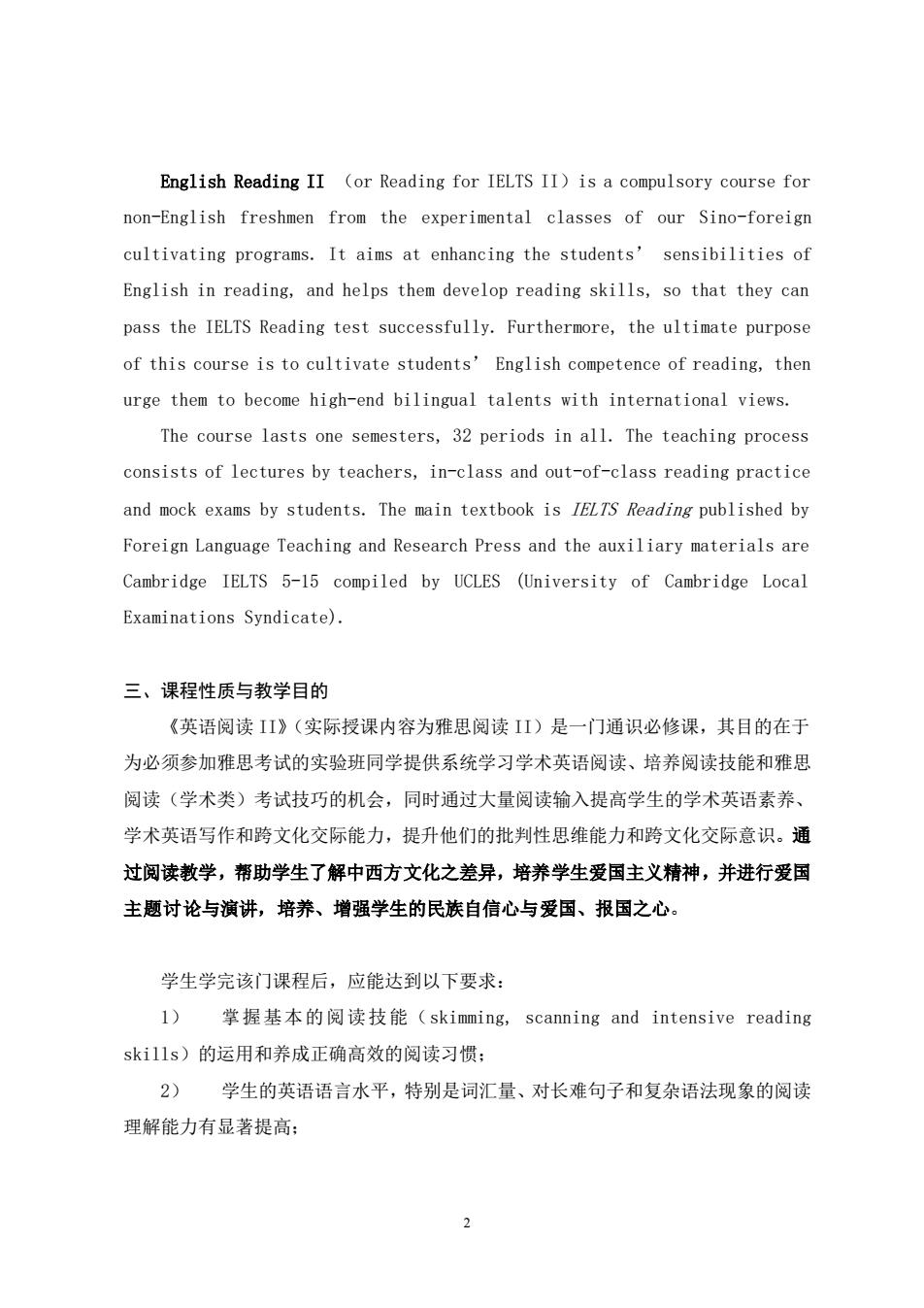
English Reading II (or Reading for IELTS II)is a compulsory course for non-English freshmen from the experimental classes of our Sino-foreign cultivating programs.It aims at enhancing the students'sensibilities of English in reading,and helps them develop reading skills,so that they can pass the IELTS Reading test successfully.Furthermore,the ultimate purpose of this course is to cultivate students'English competence of reading,then urge them to become high-end bilingual talents with international views. The course lasts one semesters,32 periods in all.The teaching process consists of lectures by teachers,in-class and out-of-class reading practice and mock exams by students.The main textbook is IELTS Reading published by Foreign Language Teaching and Research Press and the auxiliary materials are Cambridge IELTS 5-15 compiled by UCLES (University of Cambridge Local Examinations Syndicate). 三、课程性质与教学目的 《英语阅读II》(实际授课内容为雅思阅读I)是一门通识必修课,其目的在于 为必须参加雅思考试的实验班同学提供系统学习学术英语阅读、培养阅读技能和雅思 阅读(学术类)考试技巧的机会,同时通过大量阅读输入提高学生的学术英语素养、 学术英语写作和跨文化交际能力,提升他们的批判性思维能力和跨文化交际意识。通 过阅读教学,帮助学生了解中西方文化之差异,培养学生爱国主义精神,并进行爱国 主题讨论与演讲,培养、增强学生的民族自信心与爱国、报国之心。 学生学完该门课程后,应能达到以下要求: 1) 掌握基本的阅读技能(skimming,,scanning and intensive reading ski11s)的运用和养成正确高效的阅读习惯: 2)学生的英语语言水平,特别是词汇量、对长难句子和复杂语法现象的阅读 理解能力有显著提高
2 English Reading II (or Reading for IELTS II)is a compulsory course for non-English freshmen from the experimental classes of our Sino-foreign cultivating programs. It aims at enhancing the students’ sensibilities of English in reading, and helps them develop reading skills, so that they can pass the IELTS Reading test successfully. Furthermore, the ultimate purpose of this course is to cultivate students’ English competence of reading, then urge them to become high-end bilingual talents with international views. The course lasts one semesters, 32 periods in all. The teaching process consists of lectures by teachers, in-class and out-of-class reading practice and mock exams by students. The main textbook is IELTS Reading published by Foreign Language Teaching and Research Press and the auxiliary materials are Cambridge IELTS 5-15 compiled by UCLES (University of Cambridge Local Examinations Syndicate). 三、课程性质与教学目的 《英语阅读 II》(实际授课内容为雅思阅读 II)是一门通识必修课,其目的在于 为必须参加雅思考试的实验班同学提供系统学习学术英语阅读、培养阅读技能和雅思 阅读(学术类)考试技巧的机会,同时通过大量阅读输入提高学生的学术英语素养、 学术英语写作和跨文化交际能力,提升他们的批判性思维能力和跨文化交际意识。通 过阅读教学,帮助学生了解中西方文化之差异,培养学生爱国主义精神,并进行爱国 主题讨论与演讲,培养、增强学生的民族自信心与爱国、报国之心。 学生学完该门课程后,应能达到以下要求: 1) 掌握基本的阅读技能(skimming, scanning and intensive reading skills)的运用和养成正确高效的阅读习惯; 2) 学生的英语语言水平,特别是词汇量、对长难句子和复杂语法现象的阅读 理解能力有显著提高;
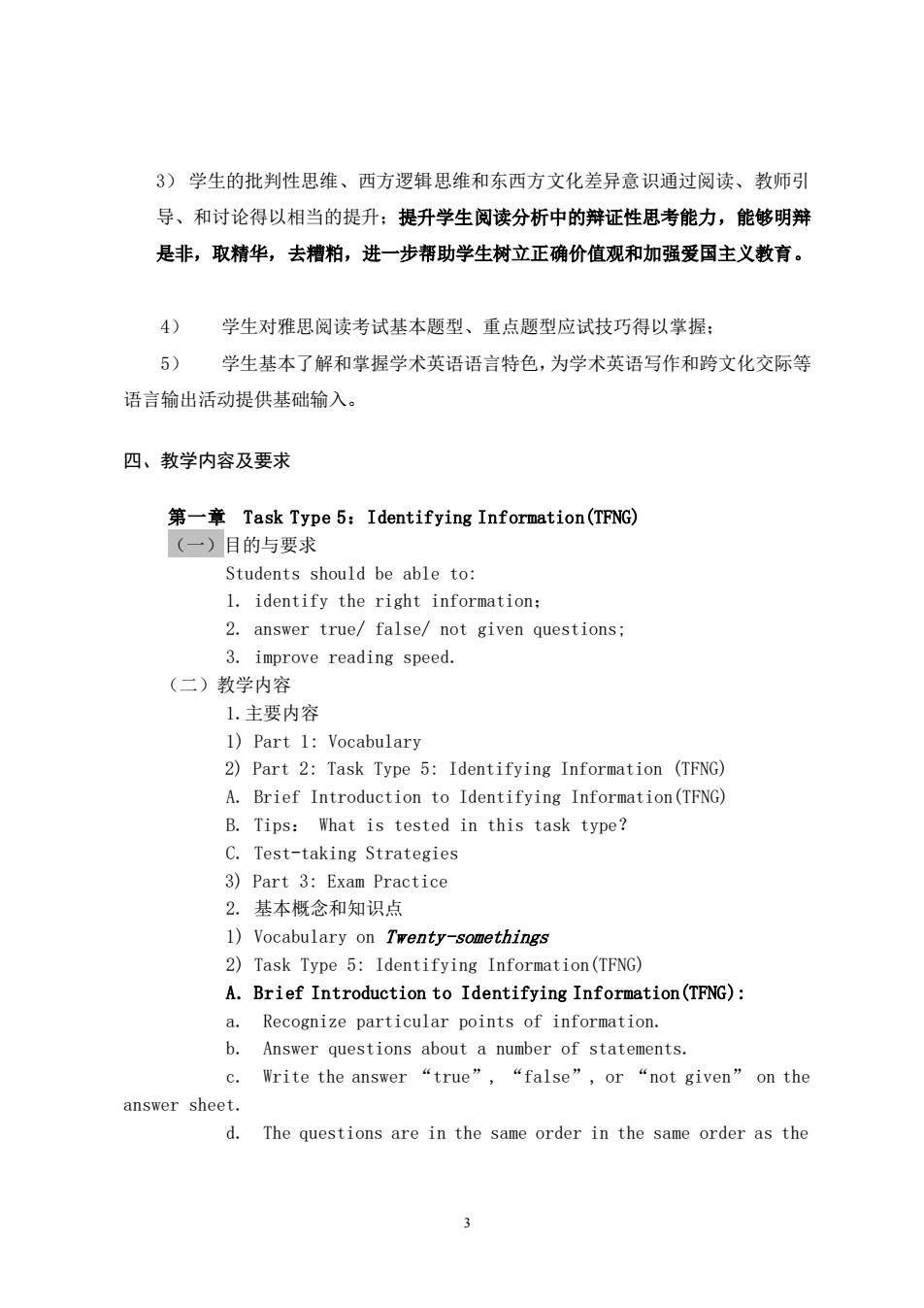
3)学生的批判性思维、西方逻辑思维和东西方文化差异意识通过阅读、教师引 导、和讨论得以相当的提升:提升学生阅读分析中的辩证性思考能力,能够明辩 是非,取精华,去糟粕,进一步帮助学生树立正确价值观和加强爱国主义教育。 4)学生对雅思阅读考试基本题型、重点题型应试技巧得以掌握 5) 学生基本了解和掌握学术英语语言特色,为学术英语写作和跨文化交际等 语言输出活动提供基础输入。 四、教学内容及要求 第一章Task Type5:Identifying Information(TFNG) (一)目的与要求 Students should be able to: 1.identify the right information: 2.answer true/false/not given questions: 3.improve reading speed. (二)教学内容 1.主要内容 1)Part 1:Vocabulary 2)Part 2:Task Type 5:Identifying Information (TFNG) A.Brief Introduction to Identifying Information(TFNG) B.Tips:What is tested in this task type? C.Test-taking Strategies 3)Part 3:Exam Practice 2.基本概念和知识点 1)Vocabulary on Twenty-somethings 2)Task Type 5:Identifying Information(TFNG) A.Brief Introduction to Identifying Information(TFNG): a.Recognize particular points of information. b.Answer questions about a number of statements. c.Write the answer“true”,“false”,or“not given”on the answer sheet. d.The questions are in the same order in the same order as the 3
3 3) 学生的批判性思维、西方逻辑思维和东西方文化差异意识通过阅读、教师引 导、和讨论得以相当的提升;提升学生阅读分析中的辩证性思考能力,能够明辩 是非,取精华,去糟粕,进一步帮助学生树立正确价值观和加强爱国主义教育。 4) 学生对雅思阅读考试基本题型、重点题型应试技巧得以掌握; 5) 学生基本了解和掌握学术英语语言特色,为学术英语写作和跨文化交际等 语言输出活动提供基础输入。 四、教学内容及要求 第一章 Task Type 5:Identifying Information(TFNG) (一)目的与要求 Students should be able to: 1. identify the right information; 2. answer true/ false/ not given questions; 3. improve reading speed. (二)教学内容 1.主要内容 1) Part 1: Vocabulary 2) Part 2: Task Type 5: Identifying Information (TFNG) A. Brief Introduction to Identifying Information(TFNG) B. Tips: What is tested in this task type? C. Test-taking Strategies 3) Part 3: Exam Practice 2. 基本概念和知识点 1) Vocabulary on Twenty-somethings 2) Task Type 5: Identifying Information(TFNG) A. Brief Introduction to Identifying Information(TFNG): a. Recognize particular points of information. b. Answer questions about a number of statements. c. Write the answer “true”, “false”, or “not given” on the answer sheet. d. The questions are in the same order in the same order as the
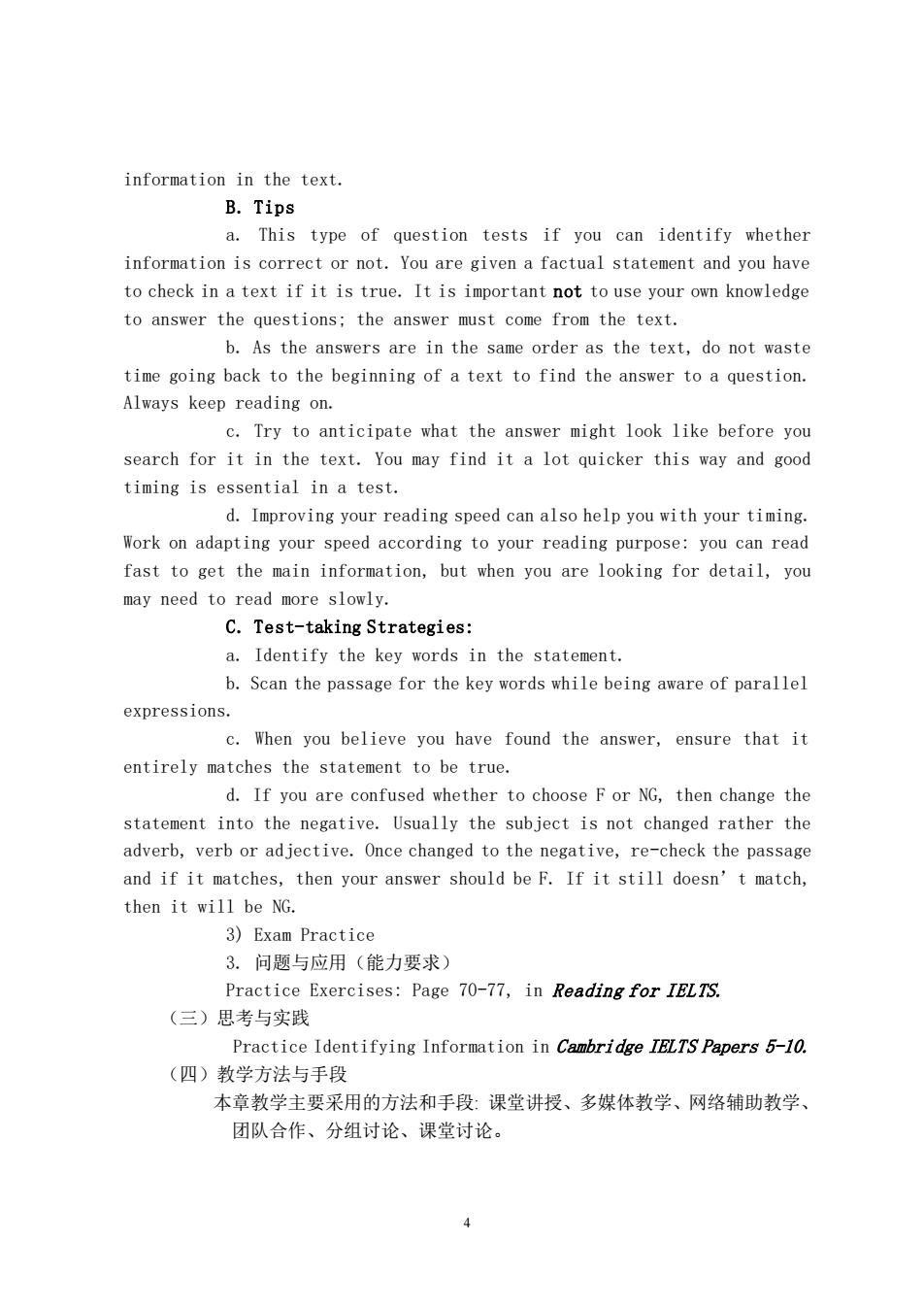
information in the text. B.Tips a.This type of question tests if you can identify whether information is correct or not.You are given a factual statement and you have to check in a text if it is true.It is important not to use your own knowledge to answer the questions;the answer must come from the text. b.As the answers are in the same order as the text,do not waste time going back to the beginning of a text to find the answer to a question. Always keep reading on. c.Try to anticipate what the answer might look like before you search for it in the text.You may find it a lot quicker this way and good timing is essential in a test. d.Improving your reading speed can also help you with your timing Work on adapting your speed according to your reading purpose:you can read fast to get the main information,but when you are looking for detail,you may need to read more slowly. C.Test-taking Strategies: a.Identify the key words in the statement. b.Scan the passage for the key words while being aware of parallel expressions. c.When you believe you have found the answer,ensure that it entirely matches the statement to be true. d.If you are confused whether to choose F or NG,then change the statement into the negative.Usually the subject is not changed rather the adverb,verb or adjective.Once changed to the negative,re-check the passage and if it matches,then your answer should be F.If it still doesn't match, then it will be NG. 3)Exam practice 3.问题与应用(能力要求) Practice Exercises:Page 70-77,in Reading for IELTS. (三)思考与实践 Practice Identifying Information in Cambridge IELTS Papers 5-10. (四)教学方法与手段 本章教学主要采用的方法和手段:课堂讲授、多媒体教学、网络辅助教学、 团队合作、分组讨论、课堂讨论。 4
4 information in the text. B. Tips a. This type of question tests if you can identify whether information is correct or not. You are given a factual statement and you have to check in a text if it is true. It is important not to use your own knowledge to answer the questions; the answer must come from the text. b. As the answers are in the same order as the text, do not waste time going back to the beginning of a text to find the answer to a question. Always keep reading on. c. Try to anticipate what the answer might look like before you search for it in the text. You may find it a lot quicker this way and good timing is essential in a test. d. Improving your reading speed can also help you with your timing. Work on adapting your speed according to your reading purpose: you can read fast to get the main information, but when you are looking for detail, you may need to read more slowly. C. Test-taking Strategies: a. Identify the key words in the statement. b. Scan the passage for the key words while being aware of parallel expressions. c. When you believe you have found the answer, ensure that it entirely matches the statement to be true. d. If you are confused whether to choose F or NG, then change the statement into the negative. Usually the subject is not changed rather the adverb, verb or adjective. Once changed to the negative, re-check the passage and if it matches, then your answer should be F. If it still doesn’t match, then it will be NG. 3) Exam Practice 3. 问题与应用(能力要求) Practice Exercises: Page 70-77, in Reading for IELTS. (三)思考与实践 Practice Identifying Information in Cambridge IELTS Papers 5-10. (四)教学方法与手段 本章教学主要采用的方法和手段: 课堂讲授、多媒体教学、网络辅助教学、 团队合作、分组讨论、课堂讨论
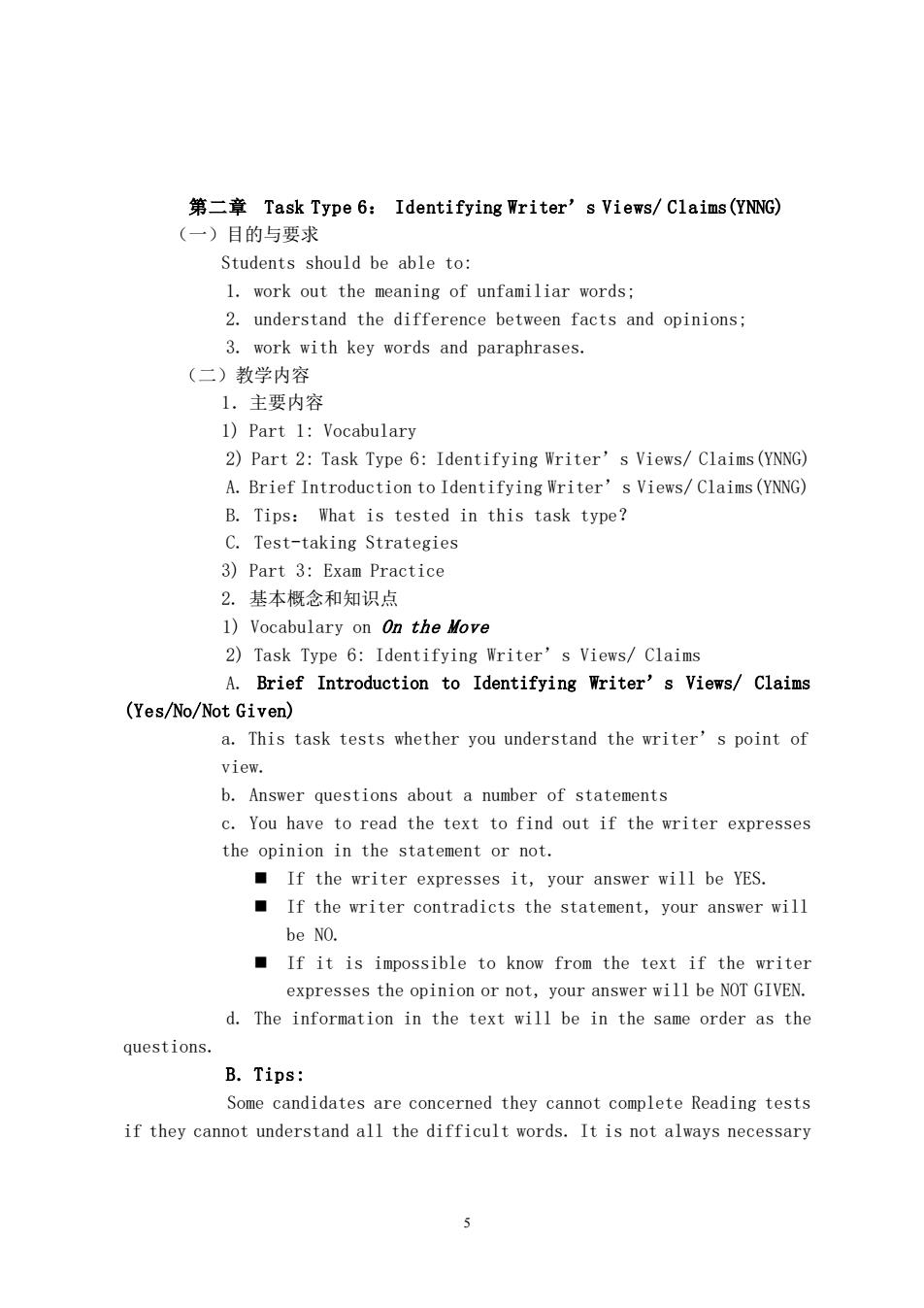
第二章Task Type6:Identifying Writer's Views/,Claims(YNG) (一)目的与要求 Students should be able to: 1.work out the meaning of unfamiliar words; 2.understand the difference between facts and opinions; 3.work with key words and paraphrases. (二)教学内容 1.主要内容 1)Part 1:Vocabulary 2)Part 2:Task Type 6:Identifying Writer's Views/Claims(YNNG) A.Brief Introduction to Identifying Writer's Views/Claims(YNNG) B.Tips:What is tested in this task type? C.Test-taking Strategies 3)Part 3:Exam Practice 2.基本概念和知识点 1)Vocabulary on On the Move 2)Task Type 6:Identifying Writer's Views/Claims A.Brief Introduction to Identifying Writer's Views/Claims (Yes/No/Not Given) a.This task tests whether you understand the writer's point of view. b.Answer questions about a number of statements c.You have to read the text to find out if the writer expresses the opinion in the statement or not. If the writer expresses it,your answer will be YES. If the writer contradicts the statement,your answer will be NO. If it is impossible to know from the text if the writer expresses the opinion or not,your answer will be NOT GIVEN. d.The information in the text will be in the same order as the questions. B.Tips: Some candidates are concerned they cannot complete Reading tests if they cannot understand all the difficult words.It is not always necessary 5
5 第二章 Task Type 6: Identifying Writer’s Views/ Claims(YNNG) (一)目的与要求 Students should be able to: 1. work out the meaning of unfamiliar words; 2. understand the difference between facts and opinions; 3. work with key words and paraphrases. (二)教学内容 1.主要内容 1) Part 1: Vocabulary 2) Part 2: Task Type 6: Identifying Writer’s Views/ Claims(YNNG) A. Brief Introduction to Identifying Writer’s Views/ Claims(YNNG) B. Tips: What is tested in this task type? C. Test-taking Strategies 3) Part 3: Exam Practice 2. 基本概念和知识点 1) Vocabulary on On the Move 2) Task Type 6: Identifying Writer’s Views/ Claims A. Brief Introduction to Identifying Writer’s Views/ Claims (Yes/No/Not Given) a. This task tests whether you understand the writer’s point of view. b. Answer questions about a number of statements c. You have to read the text to find out if the writer expresses the opinion in the statement or not. ◼ If the writer expresses it, your answer will be YES. ◼ If the writer contradicts the statement, your answer will be NO. ◼ If it is impossible to know from the text if the writer expresses the opinion or not, your answer will be NOT GIVEN. d. The information in the text will be in the same order as the questions. B. Tips: Some candidates are concerned they cannot complete Reading tests if they cannot understand all the difficult words. It is not always necessary
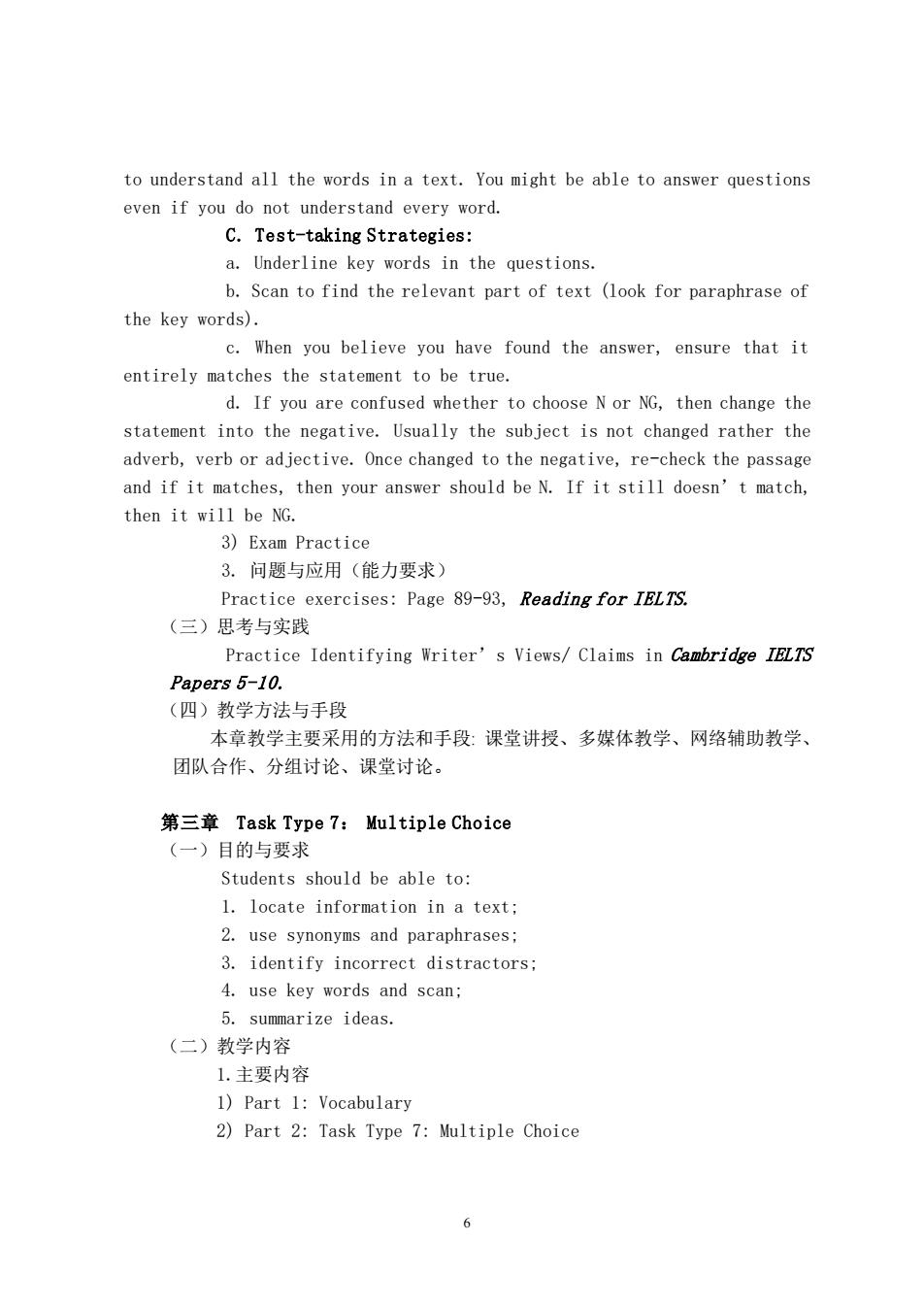
to understand all the words in a text.You might be able to answer questions even if you do not understand every word. C.Test-taking Strategies: a.Underline key words in the questions. b.Scan to find the relevant part of text (look for paraphrase of the key words). c.When you believe you have found the answer,ensure that it entirely matches the statement to be true. d.If you are confused whether to choose n or NG.then change the statement into the negative.Usually the subject is not changed rather the adverb,verb or adjective.Once changed to the negative,re-check the passage and if it matches,then your answer should be N.If it still doesn't match, then it will be NG. 3)Exam Practice 3.问题与应用(能力要求) Practice exercises:Page 89-93,Reading for IELTS. (三)思考与实践 Practice Identifying Writer's Views/Claims in Cambridge IELTS Papers 5-10. (四)教学方法与手段 本章教学主要采用的方法和手段:课堂讲授、多媒体教学、网络辅助教学 团队合作、分组讨论、课堂讨论。 第三章Task Type7:Multiple Choice (一)目的与要求 Students should be able to: 1.locate information in a text; 2.use synonyms and paraphrases: 3.identify incorrect distractors; 4.use key words and scan: 5.summarize ideas. (二)教学内容 1.主要内容 1)Part 1:Vocabulary 2)Part 2:Task Type 7:Multiple Choice 6
6 to understand all the words in a text. You might be able to answer questions even if you do not understand every word. C. Test-taking Strategies: a. Underline key words in the questions. b. Scan to find the relevant part of text (look for paraphrase of the key words). c. When you believe you have found the answer, ensure that it entirely matches the statement to be true. d. If you are confused whether to choose N or NG, then change the statement into the negative. Usually the subject is not changed rather the adverb, verb or adjective. Once changed to the negative, re-check the passage and if it matches, then your answer should be N. If it still doesn’t match, then it will be NG. 3) Exam Practice 3. 问题与应用(能力要求) Practice exercises: Page 89-93, Reading for IELTS. (三)思考与实践 Practice Identifying Writer’s Views/ Claims in Cambridge IELTS Papers 5-10. (四)教学方法与手段 本章教学主要采用的方法和手段: 课堂讲授、多媒体教学、网络辅助教学、 团队合作、分组讨论、课堂讨论。 第三章 Task Type 7: Multiple Choice (一)目的与要求 Students should be able to: 1. locate information in a text; 2. use synonyms and paraphrases; 3. identify incorrect distractors; 4. use key words and scan; 5. summarize ideas. (二)教学内容 1.主要内容 1) Part 1: Vocabulary 2) Part 2: Task Type 7: Multiple Choice
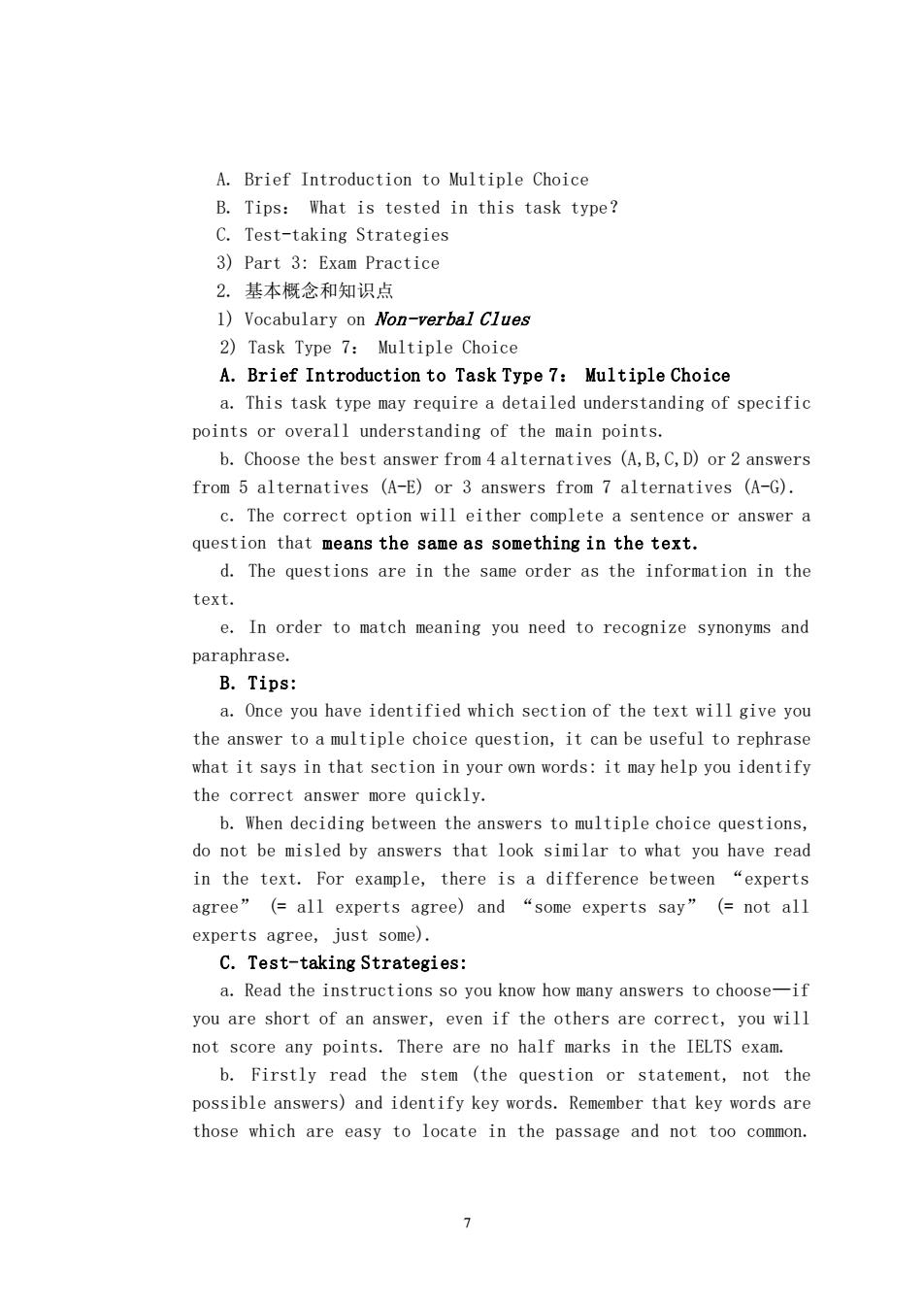
A.Brief Introduction to Multiple Choice B.Tips:What is tested in this task type? C.Test-taking Strategies 3)Part 3:Exam Practice 2.基本概念和知识点 1)Vocabulary on Non-verbal Clues 2)Task Type 7:Multiple Choice A.Brief Introduction to Task Type 7:Multiple Choice a.This task type may require a detailed understanding of specific points or overall understanding of the main points. b.Choose the best answer from 4alternatives (A,B,C,D)or 2 answers from 5 alternatives (A-E)or 3 answers from 7 alternatives (A-G). c.The correct option will either complete a sentence or answer a question that means the same as something in the text. d.The questions are in the same order as the information in the text. e.In order to match meaning you need to recognize synonyms and paraphrase. B.Tips: a.Once you have identified which section of the text will give you the answer to a multiple choice question,it can be useful to rephrase what it says in that section in your own words:it may help you identify the correct answer more quickly. b.When deciding between the answers to multiple choice questions, do not be misled by answers that look similar to what you have read in the text.For example,there is a difference between "experts agree” (=all experts agree)and "some experts say" (not all experts agree,just some). C.Test-taking Strategies: a.Read the instructions so you know how many answers to choose-if you are short of an answer,even if the others are correct,you will not score any points.There are no half marks in the IELTS exam. b.Firstly read the stem (the question or statement,not the possible answers)and identify key words.Remember that key words are those which are easy to locate in the passage and not too common. 7
7 A. Brief Introduction to Multiple Choice B. Tips: What is tested in this task type? C. Test-taking Strategies 3) Part 3: Exam Practice 2. 基本概念和知识点 1) Vocabulary on Non-verbal Clues 2) Task Type 7: Multiple Choice A. Brief Introduction to Task Type 7: Multiple Choice a. This task type may require a detailed understanding of specific points or overall understanding of the main points. b. Choose the best answer from 4 alternatives (A,B,C,D) or 2 answers from 5 alternatives (A-E) or 3 answers from 7 alternatives (A-G). c. The correct option will either complete a sentence or answer a question that means the same as something in the text. d. The questions are in the same order as the information in the text. e. In order to match meaning you need to recognize synonyms and paraphrase. B. Tips: a. Once you have identified which section of the text will give you the answer to a multiple choice question, it can be useful to rephrase what it says in that section in your own words: it may help you identify the correct answer more quickly. b. When deciding between the answers to multiple choice questions, do not be misled by answers that look similar to what you have read in the text. For example, there is a difference between “experts agree” (= all experts agree) and “some experts say” (= not all experts agree, just some). C. Test-taking Strategies: a. Read the instructions so you know how many answers to choose—if you are short of an answer, even if the others are correct, you will not score any points. There are no half marks in the IELTS exam. b. Firstly read the stem (the question or statement, not the possible answers) and identify key words. Remember that key words are those which are easy to locate in the passage and not too common

Numbers and names are often the most useful key words as they stand out in the text.If a passage is about "rainforest",then the word "rainforest"in a stem will not be useful in finding an answer,as it will appear too many times in the text.You do not need to read the answers vet.as distractors are included to confuse you. c.Quickly scan the text for the key words,but keep in mind that often you will not find exactly the same word,rather a parallel expression which is a word or expression that has a similar meaning. d.When you have found the key words.read that sentence (it may also be necessary to read the sentence before and after it)and then try to match it to one of the possible answers. 3)Exam Practice 3.问题与应用(能力要求) Practice exercises:Page 44-49,Reading for IELTS. (三)思考与实践 Practice Multiple Choice in Cambridge IELTS Papers 5-10. (四)教学方法与手段 本章教学主要采用的方法和手段:课堂讲授、多媒体教学、网络辅助教 学、团队合作、分组讨论、课堂讨论。 第四章Task Type8:Sentence Completion (一)目的与要求 Students should be able to: 1.skim-read to find information 2.recognize what is tested in the task type:Sentence Completion: 3.get familiar with tips and steps dealing with Sentence Completion. (二)教学内容 1.主要内容 1)Part 1:Vocabulary 2)Part 2:Task Type 8:Sentence Completion A.Brief Introduction to Sentence Completion B.Tips:What is tested in this task type? C.Test-taking Strategies 3)Part 3:Exam Practice 2.基本概念和知识点 8
8 Numbers and names are often the most useful key words as they stand out in the text. If a passage is about “rainforest”, then the word “rainforest” in a stem will not be useful in finding an answer, as it will appear too many times in the text. You do not need to read the answers yet, as distractors are included to confuse you. c. Quickly scan the text for the key words, but keep in mind that often you will not find exactly the same word, rather a parallel expression which is a word or expression that has a similar meaning. d. When you have found the key words, read that sentence (it may also be necessary to read the sentence before and after it) and then try to match it to one of the possible answers. 3) Exam Practice 3. 问题与应用(能力要求) Practice exercises: Page 44-49, Reading for IELTS. (三)思考与实践 Practice Multiple Choice in Cambridge IELTS Papers 5-10. (四)教学方法与手段 本章教学主要采用的方法和手段: 课堂讲授、多媒体教学、网络辅助教 学、团队合作、分组讨论、课堂讨论。 第四章 Task Type 8: Sentence Completion (一)目的与要求 Students should be able to: 1.skim-read to find information 2.recognize what is tested in the task type: Sentence Completion; 3.get familiar with tips and steps dealing with Sentence Completion. (二)教学内容 1.主要内容 1) Part 1: Vocabulary 2) Part 2: Task Type 8: Sentence Completion A. Brief Introduction to Sentence Completion B. Tips: What is tested in this task type? C. Test-taking Strategies 3) Part 3: Exam Practice 2. 基本概念和知识点
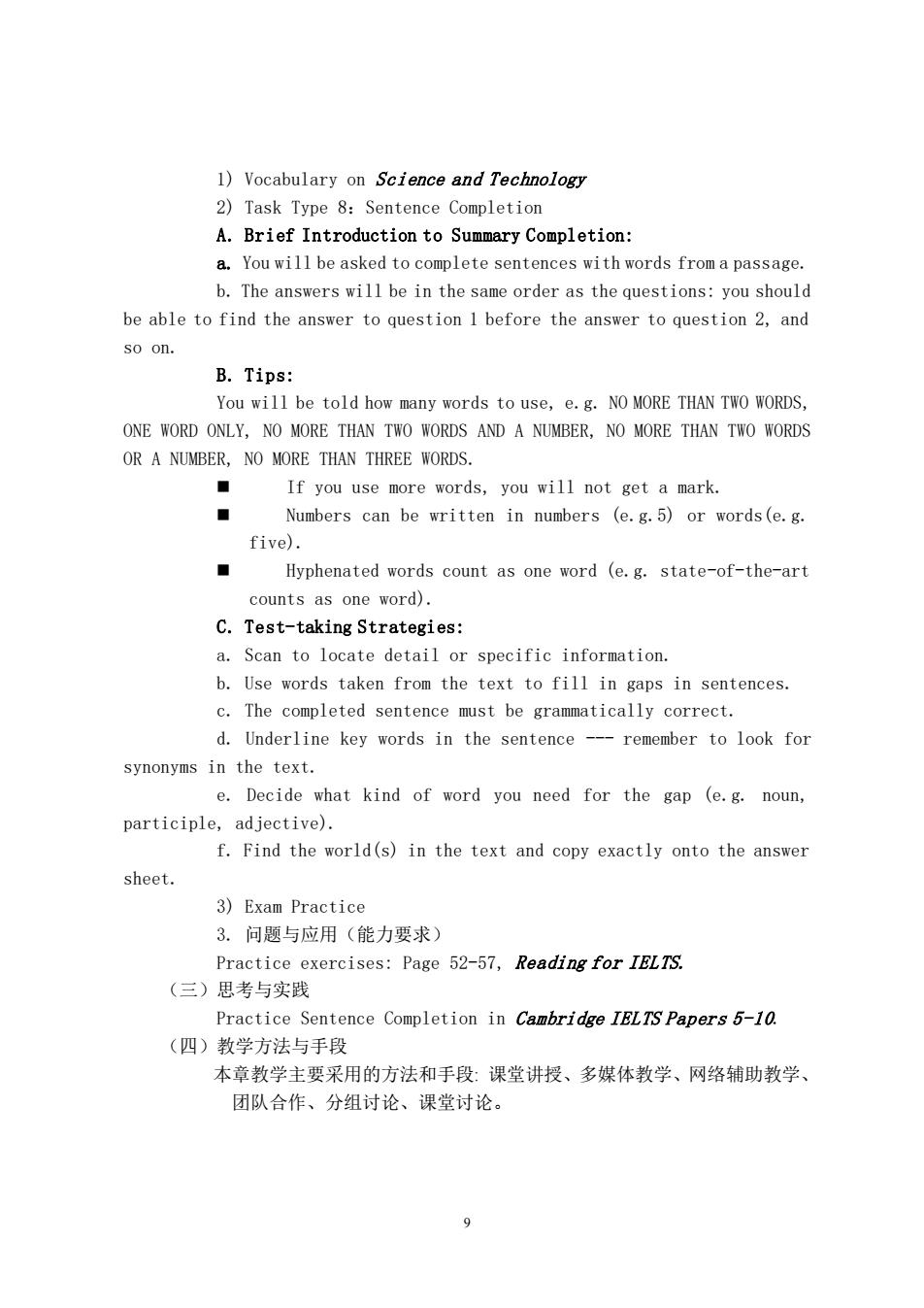
1)Vocabulary on Science and Technology 2)Task Type 8:Sentence Completion A.Brief Introduction to Summary Completion: a.You will be asked to complete sentences with words from a passage. b.The answers will be in the same order as the questions:you should be able to find the answer to question 1 before the answer to question 2,and so on. B.Tips: You will be told how many words to use,e.g.NO MORE THAN TWO WORDS. ONE WORD ONLY,NO MORE THAN TWO WORDS AND A NUMBER,NO MORE THAN TWO WORDS OR A NUMBER,NO MORE THAN THREE WORDS. ■ If you use more words.you will not get a mark. ◆ Numbers can be written in numbers (e.g.5)or words(e.g five). ◆ Hyphenated words count as one word (e.g.state-of-the-art counts as one word). C.Test-taking Strategies: a.Scan to locate detail or specific information. b.Use words taken from the text to fill in gaps in sentences. c.The completed sentence must be grammatically correct. d.Underline key words in the sentence- remember to look for synonyms in the text. e.Decide what kind of word you need for the gap (e.g.noun, participle,adjective). f.Find the world(s)in the text and copy exactly onto the answer sheet. 3)Exam Practice 3.问顾与应用(能力要求) Practice exercises:Page 52-57,Reading for IELTS. (三)思考与实践 Practice Sentence Completion in Cambridge IELTS Papers 5-10. (四)教学方法与手段 本章教学主要采用的方法和手段:课堂讲授、多媒体教学、网络辅助教学、 团队合作、分组讨论、课堂讨论
9 1) Vocabulary on Science and Technology 2) Task Type 8:Sentence Completion A. Brief Introduction to Summary Completion: a. You will be asked to complete sentences with words from a passage. b. The answers will be in the same order as the questions: you should be able to find the answer to question 1 before the answer to question 2, and so on. B. Tips: You will be told how many words to use, e.g. NO MORE THAN TWO WORDS, ONE WORD ONLY, NO MORE THAN TWO WORDS AND A NUMBER, NO MORE THAN TWO WORDS OR A NUMBER, NO MORE THAN THREE WORDS. ◼ If you use more words, you will not get a mark. ◼ Numbers can be written in numbers (e.g.5) or words(e.g. five). ◼ Hyphenated words count as one word (e.g. state-of-the-art counts as one word). C. Test-taking Strategies: a. Scan to locate detail or specific information. b. Use words taken from the text to fill in gaps in sentences. c. The completed sentence must be grammatically correct. d. Underline key words in the sentence --- remember to look for synonyms in the text. e. Decide what kind of word you need for the gap (e.g. noun, participle, adjective). f. Find the world(s) in the text and copy exactly onto the answer sheet. 3) Exam Practice 3. 问题与应用(能力要求) Practice exercises: Page 52-57, Reading for IELTS. (三)思考与实践 Practice Sentence Completion in Cambridge IELTS Papers 5-10. (四)教学方法与手段 本章教学主要采用的方法和手段: 课堂讲授、多媒体教学、网络辅助教学、 团队合作、分组讨论、课堂讨论

第五章Task Type9:Summary Completion (一)目的与要求 Students should be able to: 1.predict answers 2.locate answers in a text 3.recognize what is tested in the task type:Summary Completion; 4.get familiar with tips and steps dealing with Summary questions. (二)教学内容 1.主要内容 1)Part 1:Vocabulary 2)Part 2:Task Type 9:Summary Completion A.Brief Introduction to Summary Completion B.Tips:What is tested in this task type? C.Test-taking Strategies 3)Part 3:Exam Practice 2.基本概念和知识点 1)Vocabulary on The Job Market 2)Task Type 9:Summary Completion A.Brief Introduction to Summary Completion: a.Understand details and /or main ideas of a section of the text. b.Answers are selected either from the passage or from a list of answers. c.When taking words from the passage,check instructions for the word limit. d.Answers are not necessarily in the same order as the text. B.Tips: a.When you are completing summary,try to predict what kinds of words may be missing by using your knowledge of grammar. b.Always follow the instructions carefully,or you will lose marks. You will be told how many words to use,e.g.NO MORE THAN TWO WORDS,ONE WORD ONLY,NO MORE THAN TWO WORDS AND A NUMBER,NO MORE THAN TWO WORDS OR A NUMBER, NO MORE THAN THREE WORDS. ◆ If you use more words,you will not get a mark. Numbers can be written in numbers (e.g.5)or words (e.g.five). ◆ Hyphenated words count as one word (e.g.state-of-the-art 10
10 第五章 Task Type 9: Summary Completion (一)目的与要求 Students should be able to: 1. predict answers 2. locate answers in a text 3. recognize what is tested in the task type: Summary Completion; 4. get familiar with tips and steps dealing with Summary questions. (二)教学内容 1.主要内容 1) Part 1: Vocabulary 2) Part 2: Task Type 9: Summary Completion A. Brief Introduction to Summary Completion B. Tips: What is tested in this task type? C. Test-taking Strategies 3) Part 3: Exam Practice 2. 基本概念和知识点 1) Vocabulary on The Job Market 2) Task Type 9: Summary Completion A. Brief Introduction to Summary Completion: a. Understand details and /or main ideas of a section of the text. b. Answers are selected either from the passage or from a list of answers. c. When taking words from the passage, check instructions for the word limit. d. Answers are not necessarily in the same order as the text. B. Tips: a. When you are completing summary, try to predict what kinds of words may be missing by using your knowledge of grammar. b. Always follow the instructions carefully, or you will lose marks. You will be told how many words to use, e.g. NO MORE THAN TWO WORDS, ONE WORD ONLY, NO MORE THAN TWO WORDS AND A NUMBER, NO MORE THAN TWO WORDS OR A NUMBER, NO MORE THAN THREE WORDS. ◼ If you use more words, you will not get a mark. ◼ Numbers can be written in numbers (e.g.5) or words (e.g. five). ◼ Hyphenated words count as one word (e.g. state-of-the-art